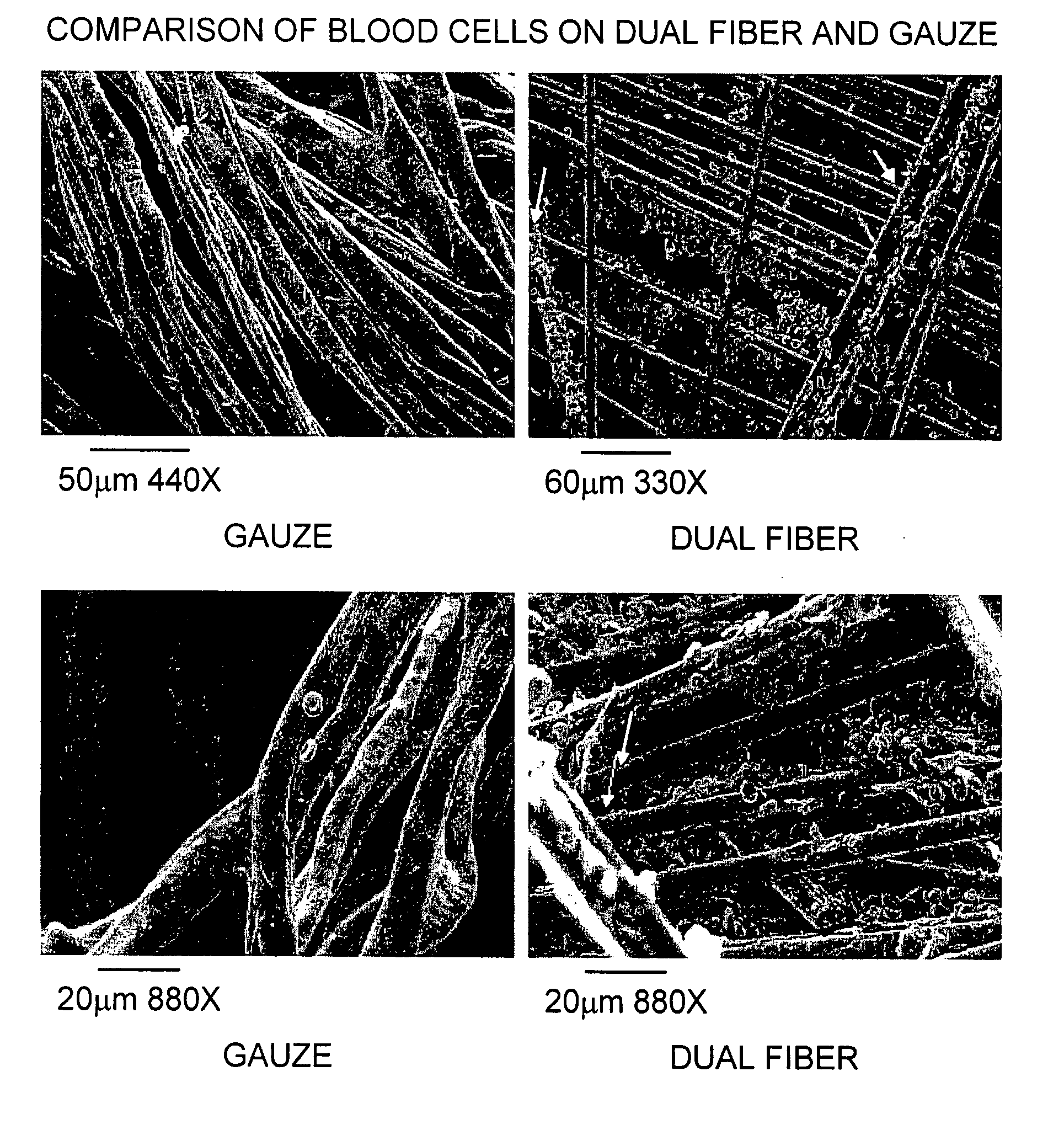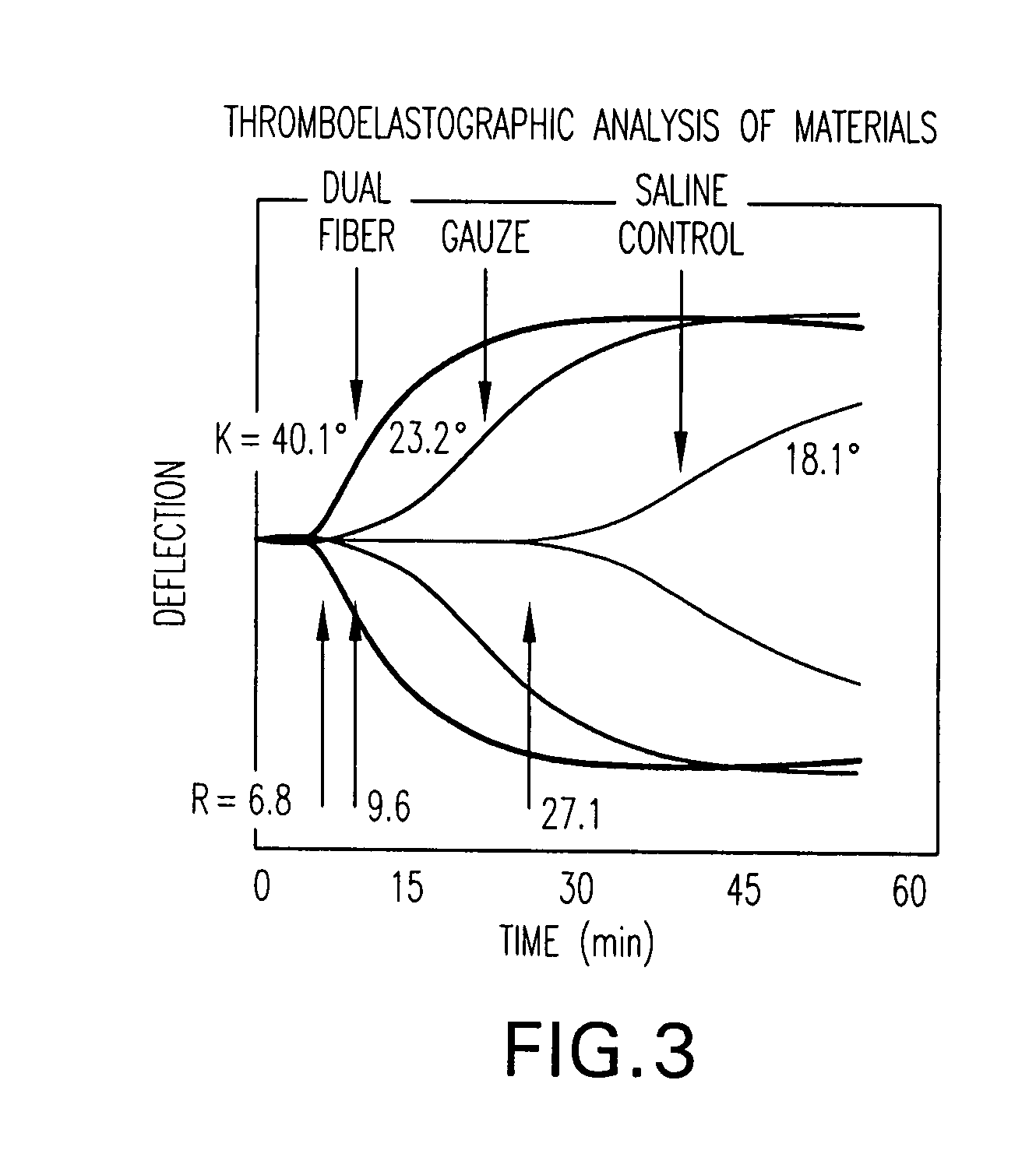Hemostatic textile
a textile and hemorrhage technology, applied in the field of textiles, can solve the problems of major contributors to morbidity and mortality, and the need for materials that can be applied to hemorrhage sites, and achieve the effects of reducing morbidity and mortality, and reducing the number of patients
- Summary
- Abstract
- Description
- Claims
- Application Information
AI Technical Summary
Benefits of technology
Problems solved by technology
Method used
Image
Examples
examples
[0069] The following examples are intended to illustrate, but in no way limit the scope of the present invention. All parts and percentages are by weight and all temperatures are in degrees Celsius unless explicitly stated otherwise.
Materials
[0070] The following solutions were used in the Examples described below.
Anticoagulant Citrate Dextrose (ACD): 0.042 M Na3Citrate, 0.035 M citric acid, 20% (w / v) anhydrous dextrose, pH to 4.5.
Citrated Saline: 6.2 mM Na3Citrate, 150 mM NaCl, pH 6.5.
Imidazole Buffered Saline: 84 mM imidazole, 150 mM NaCl, pH 6.8.
4% Paraformaldehyde: 20 grams paraformaldehyde and 9.4 grams NaH2PO4 are suspended in 400 ml deionized H2O and heated to about 60° C. in a water bath until dissolved. pH is set to 7.2 and water is added to 500 ml.
Fixative Solution (prepared immediately before use): Combine 1 ml ACD, 10 ml 0.135 Molar NaH2PO4, pH=6.5, and 9 ml 4% (w / v) paraformaldehyde.
Imidazole Buffer: 84 mM imidazole, pH=6.8
Citrate Stock: 3.2% sodium citr...
examples 1-7
Preparation of Hemostatic Textiles
[0071] The following specific textile combinations was made and used in the experiments that follow:
[0072] Textile 1: Woven style; G75 fiberglass in warp; 30 / 1 100% Bamboo Rayon OE in the Fill
[0073] The above combination was a glass fiber / bamboo co-weave with the glass fibers (G75, electronic grade E225 spun yarn from E-grade extruded glass) in the “long” orientation (warp) and the bamboo fibers running “across” the fabric (fill).
[0074] Textile 2: Woven Style; ECBC150 1 / 0 1.0 Z Fiberglass in warp; 18 / 1 100% Bamboo Rayon MJS in the fill.
[0075] Textile 3: Woven Style; ECE225 2 / 0 4.0 Z Fiberglass in warp; 18 / 3 100% Bamboo Rayon RS in the fill.
[0076] Textile 4: Knit Style; 1 end—ECG75 1 / 2 Fiberglass; 1 end—18 / 1 100% Bamboo Rayon OE in the fill.
[0077] Textile 5: Knit Style; 2 Ply—ECG150 1 / 0 Fiberglass twisted with 20 / 1 100% Bamboo Rayon.
[0078] Textile 6: Woven Style; ECE225 2 / 0 4.0 Z Fiberglass in warp; 16 / 2 100% Flax in the fill.
[0079] Textile ...
example 8
Preparation of a Hemostatic Textile Matrix that includes Thrombin
[0080] 120 mg angel hair grade glass fiber was combined with 8 ml plasma (Innovative Research, Inc., Southfield, Mich.) and 80 μl of 1M CaCl2 and placed on rocker. The mixture was mixed gently on the rocker for about 90 minutes, and the glass fiber separated from the mixture by centrifugation (300×g for 5 minutes). The supernatant was collected and glycerol was added to a final concentration of 9% by weight. The final product is a serum that contains thrombin IIa.
[0081] 50 cm2 of Textile 1 above was soaked for about 1 minute in approximately 5 ml of the above serum. Excess serum was allowed to drain off, and the soaked textile matrix was frozen at −20° C. and lyophilized.
PUM
| Property | Measurement | Unit |
|---|---|---|
| diameters | aaaaa | aaaaa |
| diameter | aaaaa | aaaaa |
| volume | aaaaa | aaaaa |
Abstract
Description
Claims
Application Information
 Login to View More
Login to View More - R&D
- Intellectual Property
- Life Sciences
- Materials
- Tech Scout
- Unparalleled Data Quality
- Higher Quality Content
- 60% Fewer Hallucinations
Browse by: Latest US Patents, China's latest patents, Technical Efficacy Thesaurus, Application Domain, Technology Topic, Popular Technical Reports.
© 2025 PatSnap. All rights reserved.Legal|Privacy policy|Modern Slavery Act Transparency Statement|Sitemap|About US| Contact US: help@patsnap.com



